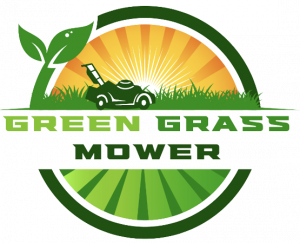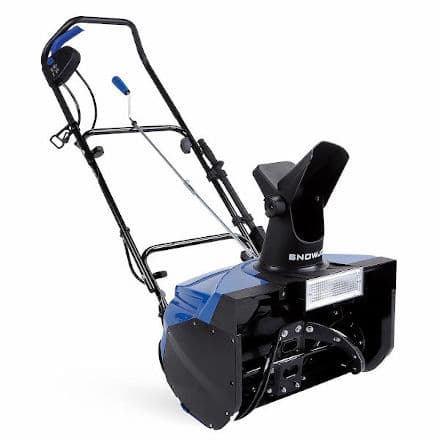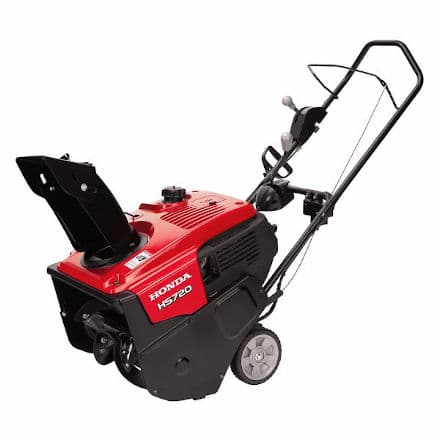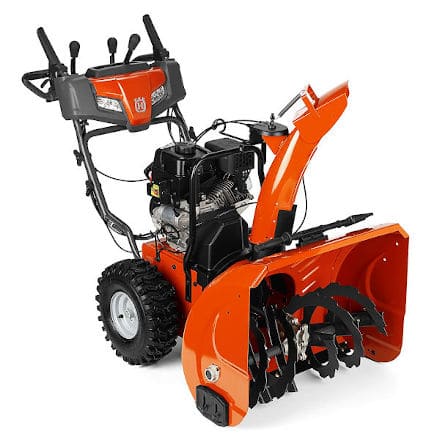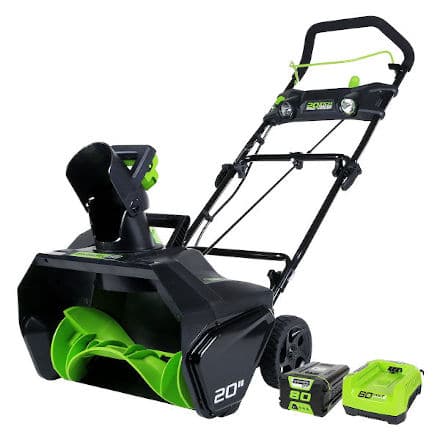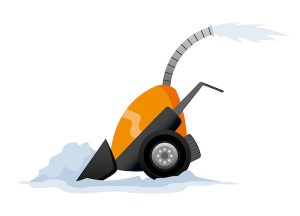 Winter is coming, where’s your snowblower? For some, this is a great reason to get hyped as one of the most beautiful times of the year is right around the corner. For others, this is a statement that brings deep fear and foreboding as the cold starts to seep its way into your life. Having the right tools to deal with the coming storm it’s always the best way to handle any change in the situation. However, finding the right snow blower is possibly just as daunting of a task as facing the blizzard itself. Like any other heavy-duty machinery, there is a wide variety of features and abilities that can make your brain spin.
Winter is coming, where’s your snowblower? For some, this is a great reason to get hyped as one of the most beautiful times of the year is right around the corner. For others, this is a statement that brings deep fear and foreboding as the cold starts to seep its way into your life. Having the right tools to deal with the coming storm it’s always the best way to handle any change in the situation. However, finding the right snow blower is possibly just as daunting of a task as facing the blizzard itself. Like any other heavy-duty machinery, there is a wide variety of features and abilities that can make your brain spin.
What’s the difference between a single, two, or three-stage model, and how can I make that work for my home? What are the new types of innovations that are entering the market that can make my purchase obsolete? There are so many things to keep in mind to avoid wasting your time and money. That’s why we put our time into making things easier for you. This snowblower shopping guide will let you know everything you need the feel confident in your snowblower purchase. You can get your heated handgrips and your power steering along with amazing tires that never go flat and the perfect chute.
Snowblowers are quite a complex piece of machinery so follow along and become an expert.
Top Rated Snow Blowers. Editor’s Choice.
- Snow Joe SJ623E
- Electric-Corded
- 2.17 hp
- 18 in.45.7 cm.
- 45.00 x 19.00 x 26.00 in.
- [usr 4.5 text="false"]

- Honda HS720ASA
- Gasoline
- 5.2 hp
- 20 in.50.80 cm
- 13.6 x 14.5 x 13.0 in.
- [usr 4.8 text="false"]
- Husqvarna ST224P
- Gasoline
- 6.3 hp
- 24 in.60.96 cm
- 41.75 x 22.75 x 25.75 in.
- [usr 4.7 text="false"]
- Greenworks Pro 80V
- Electric-Battery
- 2 hp
- 20 in.50.80 cm
- 31.00 x 21.60 x 37.00 in.
- [usr 4.5 text="false"]
Short description of best Snow Blowers
Snow Joe SJ623E
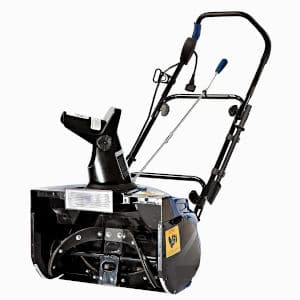 The Snow Joe SJ623E is one of the most impressive electric powered snow blowers out there. Even as electric powered snow blowers lag behind their gas-powered competition. This one manages to make a strong statement for its place. This is helped by a steel auger that puts it a step above the commonly used plastic of electric models. With an 18-inch clearing width and a 10-inch intake height, this snowblower is pretty reliable for clearing small to medium size driveways quickly. It can start to slow down though after extended use so it is recommended to work in 20 to 30 minutes sessions.
The Snow Joe SJ623E is one of the most impressive electric powered snow blowers out there. Even as electric powered snow blowers lag behind their gas-powered competition. This one manages to make a strong statement for its place. This is helped by a steel auger that puts it a step above the commonly used plastic of electric models. With an 18-inch clearing width and a 10-inch intake height, this snowblower is pretty reliable for clearing small to medium size driveways quickly. It can start to slow down though after extended use so it is recommended to work in 20 to 30 minutes sessions.
A 180-degree chute allows for easy snow blowing of up to 720 pounds per minute. A 15-amp motor gives this model considerable power but it also requires a 15-amp rated power cord. With the addition of a 2-year warranty and the 20-Watt halogen bulb for working at night, this model delivers plenty of value. The weight comes in at 34 inches for an easy to maneuver snowblower despite the lack of self-propulsion. With everything you’d expect to find and a little bit more this snowblower certainly deserves a look if you are in the market for an electric-powered model. Read full review.
Honda Power Equipment HS720ASA
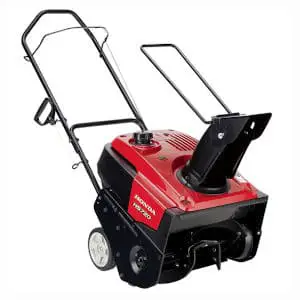 The Honda HS720ASA is an extremely powerful single stroke snowblower when compared to the rest of the market. Relying on strong materials and the resilience of the Honda brand this model is great for those who’d like a reliable machine. Dealing with maintenance is relatively easy thanks to the need for unleaded gas, a large fuel cap, recoil cord, and easy access to the spark plugs and fuel drain. On the other hand, the 9.5-inch steel auger is perfect for dealing with smaller snowstorms of eight inches or less across flatter surfaces.
The Honda HS720ASA is an extremely powerful single stroke snowblower when compared to the rest of the market. Relying on strong materials and the resilience of the Honda brand this model is great for those who’d like a reliable machine. Dealing with maintenance is relatively easy thanks to the need for unleaded gas, a large fuel cap, recoil cord, and easy access to the spark plugs and fuel drain. On the other hand, the 9.5-inch steel auger is perfect for dealing with smaller snowstorms of eight inches or less across flatter surfaces.
The biggest issue is the forward speed auger drive system that isn’t quite as automated as you would like. This model struggles to work with large slopes heavier snows and situations where you need more versatility. The electric starter is very handy for dealing with colder climates or for those who struggle with pulling tight ripcords. This model is best for flatter paved surfaces and isn’t really recommended for sloped driveways or your lawn. Read full review.
Husqvarna the ST224P
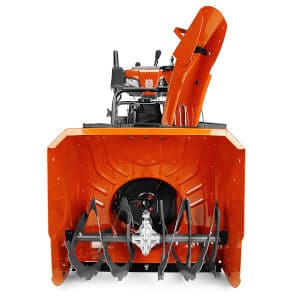 Backed by the heavy-duty brand name of Husqvarna the ST224P is one of the stronger snow blowers on the market. This model has a staggering combination of features that all start with its 24-inch two-stage gas-powered engine. A 208CC engine gives it 6.3 power horsepower which gives it the capability to easily handle up to around 16 inches of light powder. The 12-inch steel auger helps with its ability to reach a 24-inch clearing width along with its 23-inch clearing depth.
Backed by the heavy-duty brand name of Husqvarna the ST224P is one of the stronger snow blowers on the market. This model has a staggering combination of features that all start with its 24-inch two-stage gas-powered engine. A 208CC engine gives it 6.3 power horsepower which gives it the capability to easily handle up to around 16 inches of light powder. The 12-inch steel auger helps with its ability to reach a 24-inch clearing width along with its 23-inch clearing depth.
With a 6-speed friction disc transmission system, this model is capable of easily shifting up to deal with heavier slopes. The power steering is also very reliable with easy to use controls under the grips that can be activated by a single finger. The remote shoot controls are just as easy to use with smooth functionality. Other extra features like headlights and electric start and heated handlebars help this model stand out amongst its peers. Read full review.
Greenworks 2600402 Pro Snow Thrower
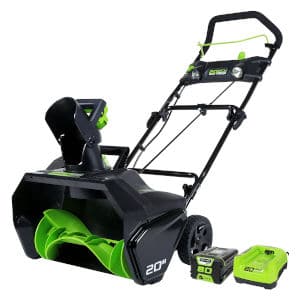 The Greenworks 2600402 Pro 80 Volt snowblower attempts to fit into an often-underappreciated market of electric powered snow blowers. Normally these snowblowers lacked the same capabilities as their gas-powered competition which causes them to lag behind. This model is a bit different though with capabilities that make it quite serviceable for certain levels of snow. With a width of nearly 20 inches and the capability to spit out around 850 pounds of snow per minute this snow blower is actually decently reliable. A heavily plastic build does take away from these models’ overall functionality, however. With a weight of 33 pounds, it is pretty light but the lack of self-propulsion still requires you to put in a decent amount of effort.
The Greenworks 2600402 Pro 80 Volt snowblower attempts to fit into an often-underappreciated market of electric powered snow blowers. Normally these snowblowers lacked the same capabilities as their gas-powered competition which causes them to lag behind. This model is a bit different though with capabilities that make it quite serviceable for certain levels of snow. With a width of nearly 20 inches and the capability to spit out around 850 pounds of snow per minute this snow blower is actually decently reliable. A heavily plastic build does take away from these models’ overall functionality, however. With a weight of 33 pounds, it is pretty light but the lack of self-propulsion still requires you to put in a decent amount of effort.
Confidently handling dry snow up to 10 inches when this snowblower moves on to wet snow and ice you can expect it to struggle a bit. The multiple passes required may be a little too much for its 45-minute runtime on a 30-minute full charge. Overall, this machine is just about the best you can expect from an electric powered snow blower even if it could use some tweaks. Read full review.
Don’t Wait to Shop!
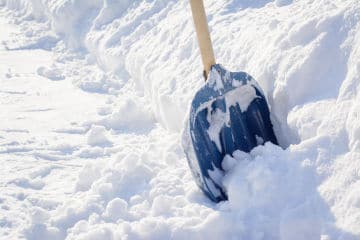 One of the biggest mistakes you can make about buying any seasonal merchandise is choosing the wrong time to start shopping. There are two strategies you can keep in mind when you begin your snowblower shopping experience. The first one will be a lot more effective than the second but it depends on your situation. These two strategies are taking the opportunity for a preemptive or postseason strike. Being prepared early is much better than toughing it out in order to prepare for next season so we’ll start with that.
One of the biggest mistakes you can make about buying any seasonal merchandise is choosing the wrong time to start shopping. There are two strategies you can keep in mind when you begin your snowblower shopping experience. The first one will be a lot more effective than the second but it depends on your situation. These two strategies are taking the opportunity for a preemptive or postseason strike. Being prepared early is much better than toughing it out in order to prepare for next season so we’ll start with that.
By the beginning of October and the end of September, most major retailers will have all of the major models fully stocked. By capitalizing on this time period with some preemptive shopping you can take advantage of all the pre-season sales. Once the snow starts coming down, you’ll notice the sales will be over and you will have to deal with the stock that is left. On the other end of the spectrum if you can tough out the season it isn’t rare to find options on sale at the end of the snow season. However, you can’t expect to find as deep a selection as different retailers treat their stocks of best snow blower patterns differently based on past seasons.
Electric Snow Blowers
While gas-powered snow blowers are certainly the classic reliable option times are changing to where some electric snow blowers are actually quite viable. These will be mostly for people who live in areas where the snowfall is often lighter. Electric snow blowers take advantage of heavy-duty winter rated extension cords to move around similarly to gas-powered blowers. This means that you will have to use some forethought to decide on a pattern that doesn’t involve you cutting your cord. However, if you can get around the negatives electric snow blowers are amazing for dealing with smaller areas.
Battery-Powered Snow Blowers
Another option that is becoming more and more valuable is the battery-powered snowblower. These eliminate even more hassles as you won’t have to deal with gas oil changes or even spark plugs. Many motors require annual service on their spark plugs. Battery-powered snow blowers allow you to work without these issues though they come with their own drawbacks. Due to the heavy energy consumption, it’s rare to find a battery-powered snow blower that can work for over 30 minutes on a single battery charge. For this reason, these machines are best used with small and average size driveways that experience light to medium snowfalls.
Single-Stage Snow Blowers
Single-stage snowblowers will make up most of the entry-level market when it comes to getting rid of snow. They operate using a single high-speed auger in order to remove the snow from the ground before shooting it out of their discharge chute. The augers are usually made of steel but also often include a rubber edge to help them move easier through the snow. Most single-stage snow blowers do not have any other form of self-propulsion. With the help of their reduced weight and the leading edge, most models rely on the user’s strength.
The majority of new gas-powered snow blowers make use of 4 cycle engines for better efficiency. This also takes away the old practice of having to mix your oil and gas. This still doesn’t remove the need to change the oil along with other seasonal maintenance. A single-stage snow blower can reliably remove compacted snow in most situations as long as it hasn’t frozen over. The average single-stage machine is built to handle areas with six inches of snowfall or less. They are also best used on driveways that accommodate about two car lengths as well as widths. Thanks to their lack of self-propulsion These type of snow blowers aren’t often recommended for people with steep driveways.
Two-Stage Snow Blowers
While you might assume that two-stage would imply having a second auger, instead a new feature is added on in the form of a high-speed impeller. The impeller acts to increase the efficiency of the snow removal process to deal with the usually much larger auger. The majority of two-stage machines make use of a corkscrew style auger that slowly turns to move the snow into the center of the unit. From there the impeller takes over to send the snow outside of the chute.
Two-stage snow blowers can work with a higher depth of snow usually topping out around 12 inches. They are also what you will want if you have a larger driveway that accommodates more than just two car lengths and widths. The typical two-stage snow blower is meant for operation with driveways that are about two cars wide and three cars long. Due to their increased weight and capabilities, the majority of two-stage snow blowers make use of some form of self-propulsion. Users should have a choice between multiple forward speeds with some even having options for moving backward. Thanks to their larger augers and more powerful engine they can chew through the snow at a much more efficient rate.
Three-Stage Snow Blowers
This is where it can start to get confusing as the difference between two and three-stage machines isn’t quite as evident as the difference between a single and a two-stage. Three-stage machines also include a slow turning auger for their operation. This auger slowly turns to move the snow into the center of the housing just like the second stage snowblower. The major difference is the speed that a three-stage snow blower is able to complete the same operation. Moving at a much faster rate a three-stage snow blower is liable to move snow at around a 50% faster speed than a comparably sized two-stage snowblower. They offer the greatest snow blowing efficiency outside of moving up to industrial level models.
These are the machines for those who live in climates with heavy snow with their ability to handle depths of up to 18 inches. They are also recommended for large driveways that reach out to three cars wide and four cars long. With their increased complexity these snow blowers make use of multiple belts that will require maintenance eventually. Two-stage snow blowers use drive belts as well along with single-stage but you will see an increase in belts as you move up.
Driveway Construction and Slope
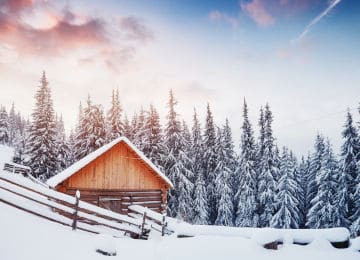 When purchasing your snow blower, you want to take certain things into consideration. Snowblowers are commonly used for driveways and walkways with very few being made for the yard. With this in mind, the makeup of your driveway is very important when deciding on your snowblower. If you have a flat concrete or asphalt driveway then a single-stage snow blower would likely be appropriate. Though once you start throwing in the steepness of an incline. Along with other materials such as gravel or dirt driveways, a single-stage snow blower no longer suffices.
When purchasing your snow blower, you want to take certain things into consideration. Snowblowers are commonly used for driveways and walkways with very few being made for the yard. With this in mind, the makeup of your driveway is very important when deciding on your snowblower. If you have a flat concrete or asphalt driveway then a single-stage snow blower would likely be appropriate. Though once you start throwing in the steepness of an incline. Along with other materials such as gravel or dirt driveways, a single-stage snow blower no longer suffices.
Due to the single stages rubber-tipped auger, it will scrape up the snow as well as your pavement into its housing. Not only will this destroy the rubber auger forcing you to replace it sooner it will also spew gravel or dirt all over your lawn. Single-stage snow blowers are also poor for steep or sloped driveways thanks to the effort required for pushing without self-propulsion. This makes it so a two or three-stage snow blower is an absolute necessity for gravel driveways or steep ones. Their augers using the corkscrew design don’t scrape the ground in the same fashion as well as providing the self-propulsion to get the job done on hills
The Type of Snow
You definitely want to keep in mind the type of snow you most often receive when considering your snowblower. The average snowfall depth is the first consideration but those who live in especially snowy climates know there are many types of snowfall. You can’t rely on a single-stage snow blower if you live in a place where most of the snow is often wet and sticky. For those regions, you will definitely want to go the extra mile to opt for a self-propelled two or three-stage snow blower regardless of your driveway size. Stepping up to a two-stage snow blower is often recommended because it will be much easier on your back. The more powerful your engine the less it will be slowed down by heavy wet snow. For those who are used to soft powdery snow, a single-stage snow blower should work well enough.
Electric Start Saves Time and Effort
With the majority of snow blowers making use of gasoline engines starting up in cold weather can be an issue. Once a snowblower’s engine is flooded it could take over 20 strong pulls in order to get it clear to begin working. The larger the engine the more strength will be required to pull as well. For this reason, many consumers opt for electric start machines that are able to plug into your AC outlet. These machines start with a push of the button for quick and easy operation.
Chute Control
You also want to keep in mind how well your snow blowers chute operates. Whenever you get to the end of your path it is often required that you change the direction of your chute. This is also necessary when there are changes in the wind. For this reason, having it as simple as possible chute rotation is going to make the job easier. On lower-end machines, your chute rotation mechanism is normally a crank that will require you to stop and take the time to turn before moving on.
You will likely also have to adjust the pitch of your suit in order to decide how far you want the snow thrown. When you move up to more pricey models you will find different cable and electronic chute rotation mechanisms. These operations often allow changes simply from the control panel of the machine. You could also find models with a one-hand pistol-grip joystick chute control. These help you operate quickly and the smoother the chute controls the easier it is to work with.
Chute Build
 Chutes often come in two styles of the build being made of either plastic or steel. Why you might expect steel to be the better way to go plastic chutes are quickly becoming the taste for the market. Plastic chutes are actually going to work better for the task and last longer than their steel competitors. Because plastic chutes are more slippery in cold weather you won’t have to worry about the snow jamming or sticking as easily.
Chutes often come in two styles of the build being made of either plastic or steel. Why you might expect steel to be the better way to go plastic chutes are quickly becoming the taste for the market. Plastic chutes are actually going to work better for the task and last longer than their steel competitors. Because plastic chutes are more slippery in cold weather you won’t have to worry about the snow jamming or sticking as easily.
Plastic chutes also are more flexible as well so they will not crack in cold weather. Steel discharge chutes deal with chips and dents much worse. They can also start to rust over time which will cause snow to stick to the chute. With too much snow stuck to the chute, you will have to stop your machine and clear it out due to jams.
Power Steering is a Clutch
While you won’t often see it in the single-stage snowblowers power steering is something you should certainly look out for. More commonly found in two and three-stage snow blowers due to their increased weight, power steering can be essential. Turning around your snowblower at the end of the path can cause considerable wear and tear to your body. However, power steering comes through to allow these models to turn on a dime. Some of the newest models have one-handed power steering controls that allow you to quickly pull and turn the machine 180 degrees like slicing through butter. Without solid power steering, you might not even want to deal with pulling your snowblower out.
Tires
Your tires are going to be your snow blower’s main unit of transportation so having ones that are reliable is very important. You want to try to avoid pneumatic air-filled tires if you can. This is because they often require refilling and once they bust repairing one is difficult, especially in poor circumstances. Another issue is that if one tire has less air pressure than the other the snowblower will pull to that side. The best solution is to opt for airless tires because they will never go flat or have balance issues. These tires are made from a polymer material that allows them to shed the snow while still having the same level of traction as your traditional tires. Eliminating the maintenance and stopping you from sidetracking allows you to complete your task with utmost efficiency.
Headlights
You will most likely want to grab headlights for your snow blower if you can find them in a model. This is because snow doesn’t often come until winter when the days are shorter and the nights are longer. If you live in an area with heavy snowfall you won’t always be able to clear the snow in daylight. For this reason, the proper headlights can be essential. Basic headlights will use halogen bulbs which give a decently strong light for less price. The next step up will be LED lights for most models which are more energy-efficient while also creating more powerful light. You could also opt for high-intensity discharge lights or even newer laser headlights but those will often be found in the most expensive models.
Conclusion

Finding the right snow blower for you doesn’t have to be a nerve-wracking decision-making process. It can be as simple as realizing the climate that you live in and your average snowfall and matching that with the right range of snow blowers for you. Once you know your range it isn’t too difficult to start finding the best deal for that type of snowblower.
Some extra features like heated handlebars are overrated as they barely ever reach what you would hope for. The best way to ensure that you aren’t shopping again in a year is to choose a reliable brand with a model that suits your climate. Cutting corners on your snowblower is an easy way to end up snowed in.
